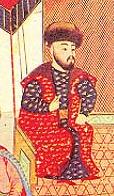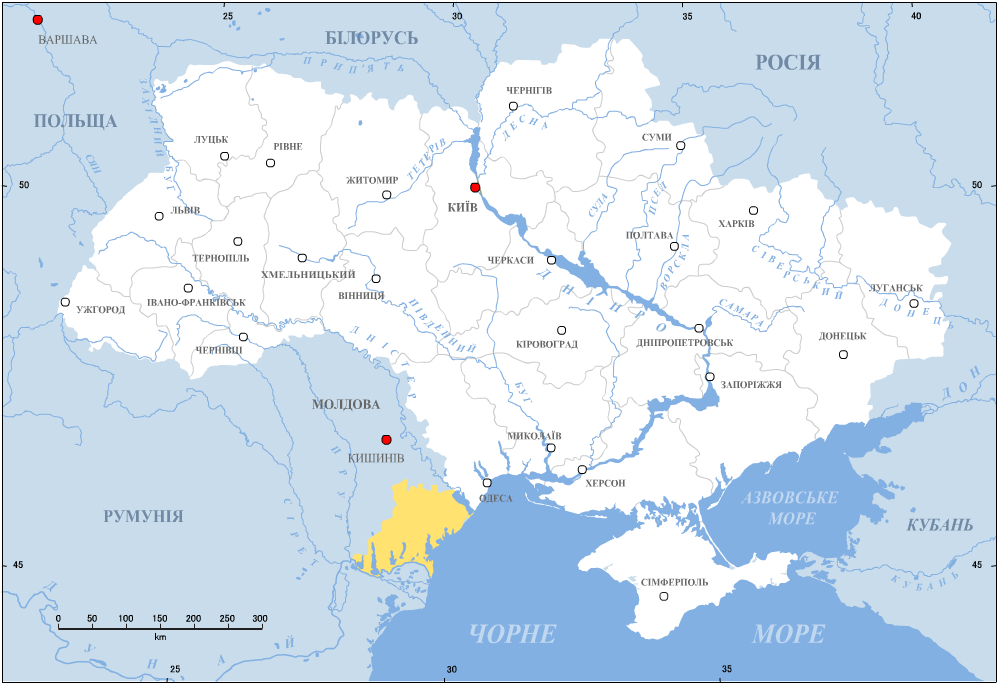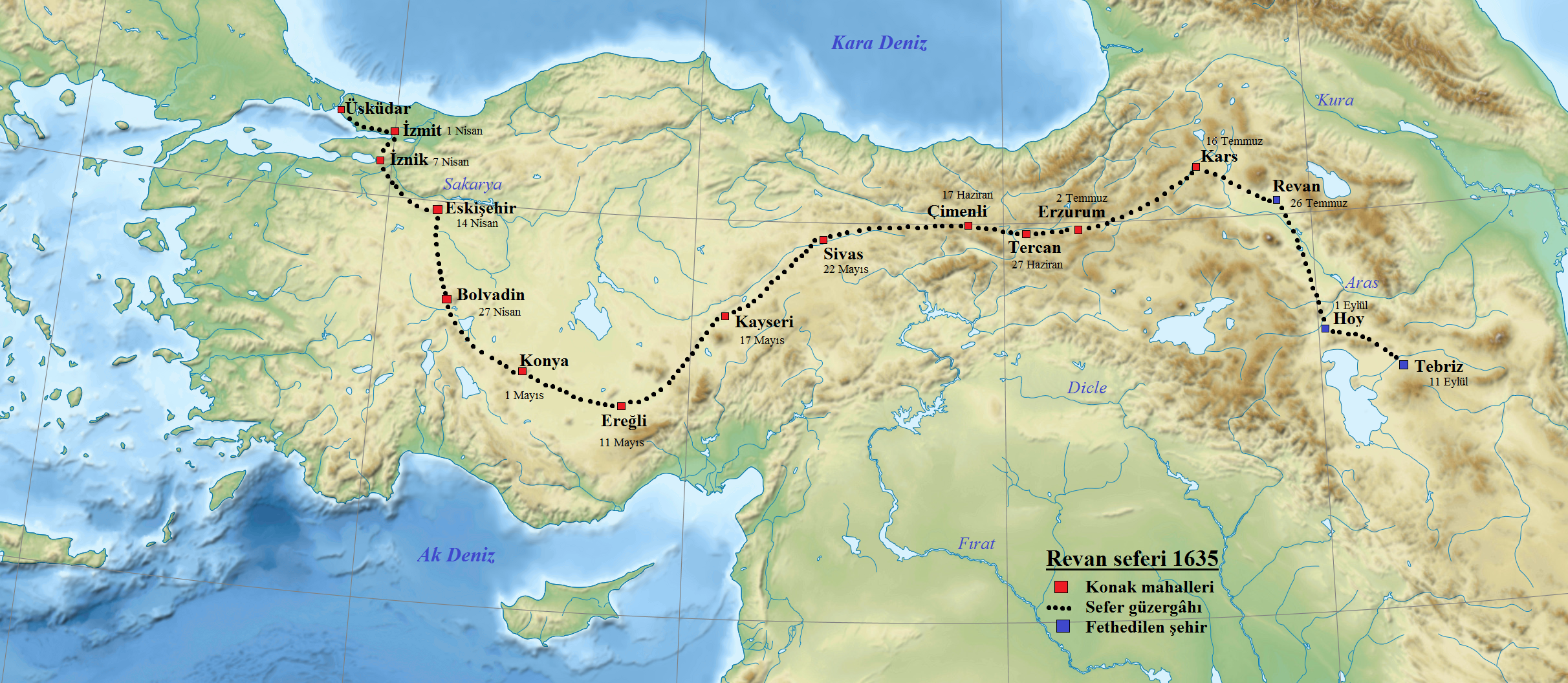|
Bahadır I Giray
Bahadir or Bahadır I Giray (1602–1641, reigned 1637–1641) was a khan of the Crimean Khanate. Much of his reign was spent dealing with Azov which had been captured by the Don Cossacks. Unlike many khans, he died of natural causes. He was the father of Selim I Giray and, through him, the ancestor of all khans who reigned after 1700 except for Devlet III. Early life and enthronement He was the son of Selâmet I Giray who reigned from 1608 to 1610. During his father's reign he was sent to Turkey as a ‘rekhin’ or honorable hostage. He grew up on an estate near Yambol. He was described as handsome, learned, eloquent and something of a poet. In June 1637 the Turks deposed İnayet Giray and placed Bahadir on the throne. As kalga and nureddin he chose the brothers Islyam and Safa Girai. Just after coming to the throne he learned that the Don Cossacks had captured Azov. Reign and Azov problem Azov, or Azak as it was then called, lies at the northeast corner of the Sea of Azov, at ... [...More Info...] [...Related Items...] OR: [Wikipedia] [Google] [Baidu] |
Crimean Khanate
The Crimean Khanate ( crh, , or ), officially the Great Horde and Desht-i Kipchak () and in old European historiography and geography known as Little Tartary ( la, Tartaria Minor), was a Crimean Tatars, Crimean Tatar state existing from 1441 to 1783, the longest-lived of the Turkic khanates that succeeded the empire of the Golden Horde. Established by Hacı I Giray in 1441, it was regarded as the direct heir to the Golden Horde and to Cumania, Desht-i-Kipchak. In 1783, violating the 1774 Treaty of Küçük Kaynarca (which had guaranteed non-interference of both Russia and the Ottoman Empire in the affairs of the Crimean Khanate), the Russian Empire Annexation of Crimea by the Russian Empire, annexed the khanate. Among the European powers, only France came out with an open protest against this act, due to the longstanding Franco-Ottoman alliance. Naming and geography Crimean khans, considering their state as the heir and legal successor of the Golden Horde and Desht-i Kipchak, ... [...More Info...] [...Related Items...] OR: [Wikipedia] [Google] [Baidu] |
Yevpatoria
Yevpatoria ( uk, Євпаторія, Yevpatoriia; russian: Евпатория, Yevpatoriya; crh, , , gr, Ευπατορία) is a city of regional significance in Western Crimea, north of Kalamita Bay. Yevpatoria serves as the administrative center of Yevpatoria Municipality, one of the districts (''raions'') into which Crimea is divided. It had a population of History Greek settlement The first recorded settlement in the area, called ''Kerkinitis'' (), was built by Greek colonists around 500 BCE. Along with the rest of the Crimea, Kerkinitis formed part of the dominions of King Mithridates VI Eupator ( BCE), from whose nickname, ''Eupator'' "of noble father" the city's modern name derives. Khanate period From roughly the 7th through the 10th centuries, Yevpatoria was a Khazar settlement; its name in Khazar language was probably ''Güzliev'' (literally "beautiful house"). It was later subject to the Cumans ( Kipchaks), the Mongols and the Crimean Khanate. During t ... [...More Info...] [...Related Items...] OR: [Wikipedia] [Google] [Baidu] |
1641 Deaths
Events January–March * January 4 – The stratovolcano Mount Parker (Philippines), Mount Parker in the Philippines) has a major eruption. * January 18 – Pau Claris proclaims the Catalan Republic (1641), Catalan Republic. * February 16 – King Charles I of England gives his assent to the Triennial Act, reluctantly committing himself to parliamentary sessions of at least fifty days, every three years. * March 7 – King Charles I of England decrees that all Roman Catholic priests must leave England by April 7 or face being arrested and treated as traitors. * March 22 – The trial for high treason begins for Thomas Wentworth, 1st Earl of Strafford, director of England's Council of the North. * March 27 – **The Battle of Preßnitz, Battle of Pressnitz begins between the Holy Roman Empire and Sweden. **The Siege of São Filipe begins in the Azores as the Portuguese Navy fights to drive the Spanish out. After almost 11 months, the Portuguese ... [...More Info...] [...Related Items...] OR: [Wikipedia] [Google] [Baidu] |
1602 Births
Sixteen or 16 may refer to: *16 (number), the natural number following 15 and preceding 17 *one of the years 16 BC, AD 16, 1916, 2016 Films * '' Pathinaaru'' or ''Sixteen'', a 2010 Tamil film * ''Sixteen'' (1943 film), a 1943 Argentine film directed by Carlos Hugo Christensen * ''Sixteen'' (2013 Indian film), a 2013 Hindi film * ''Sixteen'' (2013 British film), a 2013 British film by director Rob Brown Music *The Sixteen, an English choir *16 (band), a sludge metal band * Sixteen (Polish band), a Polish band Albums * ''16'' (Robin album), a 2014 album by Robin * 16 (Madhouse album), a 1987 album by Madhouse * ''Sixteen'' (album), a 1983 album by Stacy Lattisaw *''Sixteen'' , a 2005 album by Shook Ones * ''16'', a 2020 album by Wejdene Songs * "16" (Sneaky Sound System song), 2009 * "Sixteen" (Thomas Rhett song), 2017 * "Sixteen" (Ellie Goulding song), 2019 *"16", by Craig David from ''Following My Intuition'', 2016 *"16", by Green Day from ''39/Smooth'', 1990 *"16", by H ... [...More Info...] [...Related Items...] OR: [Wikipedia] [Google] [Baidu] |
Mehmed IV Giray
Mehmed IV Giray, the Sufi (1610–1674), was khan of the Crimean Khanate in 1641–1644 and 1654–1666. His two reigns were interrupted by that of his brother Islyam III Giray. His first reign was uneventful, except for the recapture of Azov from the Cossacks. His second reign was spent fighting Russians and Cossacks in alliance with Poland. He had some reputation as a poet. Family and early life Previous khans were 1608–10: his father Selâmet I Giray, 1610: his cousin Canibek Giray, 1623: his cousin's son Mehmed III Giray, 1628: Canibek again, 1635: his cousin İnayet Giray and 1637: his brother Bahadır I Giray. For his many brothers and nephews see Selâmet I Giray#His sons. None of Mehmed's sons or grandsons became khans. In 1632–35 he was nureddin or kalga during the second reign of Canibek Giray. He then went to Ottoman territory, probably accompanying the deposed Canibek. What he did during the reigns of Inayet and Bahadir does not seem to be recorded. First rei ... [...More Info...] [...Related Items...] OR: [Wikipedia] [Google] [Baidu] |
List Of Crimean Khans
This is a list of khans of the Crimean Khanate, a state which existed in present-day southern Ukraine from 1441 until 1783. Crimean Tatars, although not a part of the Ukrainian Ethnic group, ethnos, are deeply interconnected, having ruled a large part of modern History of Ukraine, Ukraine over the span of 300 years. The position of Khan in Crimea was electoral and was picked by beys from four of the most noble families (also known as Qarachi beys: Argyns, Kipchaks, Shirins, and Baryns) at kurultai where the decision about a candidate was adopted.Giray - Khan dynasty of Crimea Khan's Palace website (unavailable currently). The newly elected Khan was raised on a white felt sheet and over him were read Islamic prayers, after that the Khan was triumphantly enthroned. [...More Info...] [...Related Items...] OR: [Wikipedia] [Google] [Baidu] |
Sulyma Uprising
The Sulyma uprising ( pl, Powstanie Sulimy, uk, Повстання Сулими, ''Povstannia Sulymy'') was a Cossack rebellion headed by Ivan Sulyma (Iwan Sulima) against the Polish–Lithuanian Commonwealth in 1635. The rebels succeeded in taking and destroying the newly built Kodak Fortress, but were defeated by Polish forces under Hetman Stanisław Koniecpolski soon afterward. Sulyma was executed in December same year. Background The Polish–Lithuanian Commonwealth controlled most of the Cossack territories at the time, and their nobility was trying to turn militant Cossacks into serfs. The Cossacks were also responsible for provoking some conflicts with the Ottoman Empire. To secure the troublesome south-eastern border, the Commonwealth began construction of a new fortress, the Kodak fortress, finished in July 1635. Uprising Soon after the Kodak fortress was finished, after returning from a raid to the Black Sea against the Ottomans, Cossack leader Ivan Sulyma decided to ... [...More Info...] [...Related Items...] OR: [Wikipedia] [Google] [Baidu] |
Kodak Fortress
Kodak fortress ( uk, Кодак; pl, Kudak) was a fort built in 1635 by the order of the Polish king Władysław IV Vasa and the Sejm on the Dnieper River near what would become the town of Stari Kodaky (now near the city of Dnipro in Ukraine). In 1711, according to the Treaty of the Pruth the fortress was destroyed by the Russians. History It was constructed by Stanisław Koniecpolski to control Cossacks of the Zaporizhian Sich, to prevent Ukrainian peasants from joining forces with the Cossacks and to guard the southeastern corner of the Polish–Lithuanian Commonwealth. The Poles tried to establish order in that area, and commissioned French military cartographer and engineer William le Vasseur de Beauplan to construct the fort. The building cost around 100,000 Polish zlotys. The annual maintenance of eight thousand registered Cossacks also cost about 100,000 Polish zlotys. The dragoon garrison was commanded by the French officer Jean de Marion. Shortly after construction w ... [...More Info...] [...Related Items...] OR: [Wikipedia] [Google] [Baidu] |
Budjak Horde
The Budjak Horde or Belgorod Horde formed part of the Nogai Horde in the 17th and 18th centuries. It settled in the northern Black Sea coast area under protectorate of the Crimean Khanate and the Ottoman Empire's Sanjak of Ozu (Yedisan). Its capital was in Căușeni. In the 1620s the horde migrated from the Pontic steppes to the steppes of the Budjak region. The Bilhorod Tatars (20,000-30,000) were nomadic herdsmen. They made forays for slaves and loot into Right-bank Ukraine and Moldavia. In 1770 the horde became a protectorate of the Russian Empire and soon after was dispersed through resettlement in the Azov steppes. From there its remnants emigrated to Turkey during the Crimean War of 1853-1856. Prominent leaders of the horde included Khan Temir (died 1637), who allegedly established the noble Moldavian family of Cantemirești. Leaders * 1603–1637 Khan Temir * Giray family with rank of Serasker References External links Bilhorod Hordeat the Encyclopedia of Ukra ... [...More Info...] [...Related Items...] OR: [Wikipedia] [Google] [Baidu] |
Gazi Hüseyin Pasha
Gazi Hüseyin Pasha ("Hüseyin Pasha the Warrior"; died 1659), also known as Deli Hüseyin Pasha ("the Mad") or Sarı Hüseyin Pasha ("the Blonde") or Baltaoğlu Hüseyin Pasha ("of the Axe"), was an Ottoman military officer and statesman. He was governor of Egypt (1635–1637),Süreyya, Bey Mehmet, Nuri Akbayar, and Seyit Ali. Kahraman. Sicill-i Osmanî. Beşiktaş, İstanbul: Kültür Bakanlığı Ile Türkiye Ekonomik Ve Toplumsal Tarih Vakfı'nın Ortak Yayınıdır, 1890. Print. Kapudan Pasha in the 1630s, and briefly Grand Vizier in 1656. Background Hüseyin was of Turkish origin and was born in Yenişehir near Bursa in northwest Anatolia. Other than that, little is known about his early days in Constantinople (present İstanbul), the Ottoman capital. During the reign of Sultan Murad IV, he was a member of palace staff. The Shah Safi of Persia had sent Murad IV a prestigious gift, a bow which was reputed as being undrawable. Hüseyin attracted attention when he easily ... [...More Info...] [...Related Items...] OR: [Wikipedia] [Google] [Baidu] |
Selim I Giray
Selim I Giray, Selim Khan Girai ( crh, I Selim Geray, tr, 1. Selim Giray) was four times khan of the Crimean Khanate in the period from 1671 to 1704. During this time Crimean khans were regularly appointed and replaced by the Ottomans. The main events of the period were the continuing conflicts in Ukraine, the Russian capture of Azov and the Great Turkish War during which the Turks were pushed back from Vienna to about the line of Belgrade. Unlike other khans of the period, he ruled well and had no conflicts with his nobles. He was born in 1631. Background Crimean khans were the direct descendants of Genghis Khan, the Mongol Emperor. After the death of Genghis Khan (1227) the empire was partitioned and the part in East Europe and Northwest Asia was named Golden Horde. The Golden Horde khans embraced Islam. That region which was also called Desht-i Qipchaq was the home of Kypchak Turks and the khanate was Turkified. In the early 15th century Golden Horde was further partiti ... [...More Info...] [...Related Items...] OR: [Wikipedia] [Google] [Baidu] |
Ottoman–Safavid War (1623–1639)
The Ottoman–Safavid War of 1623–1639 was the last of a series of conflicts fought between the Ottoman Empire and Safavid Empire, then the two major powers of Western Asia, over control of Mesopotamia. After initial Persian success in recapturing Baghdad and most of modern Iraq, having lost it for 90 years, the war became a stalemate as the Persians were unable to press further into the Ottoman Empire, and the Ottomans themselves were distracted by wars in Europe and weakened by internal turmoil. Eventually, the Ottomans were able to recover Baghdad, taking heavy losses in the final siege, and the signing of the Treaty of Zuhab ended the war in an Ottoman victory. Roughly speaking, the treaty restored the borders of 1555, with the Safavids keeping Dagestan, eastern Georgia, Eastern Armenia, and the present-day Azerbaijan Republic, while western Georgia and Western Armenia decisively came under Ottoman rule. The eastern part of Samtskhe (Meskheti) was irrevocably lost to the ... [...More Info...] [...Related Items...] OR: [Wikipedia] [Google] [Baidu] |

.jpg)




